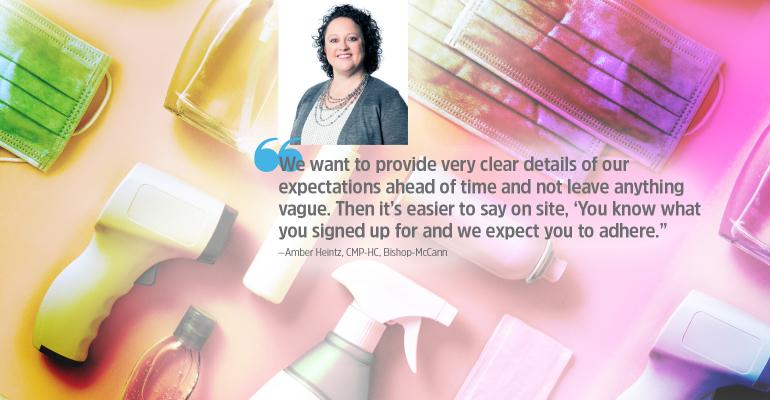To execute a pandemic-era meeting without logistical complications or uncomfortable personal interactions, organizers must communicate clearly and repeatedly to attendees in advance about expected behavior on site.
A few weeks ahead of a late 2020 in-person sales-kickoff event for 200 reps, Christine Hilgert, CMP, senior vice president of Meeting Expectations, worked with her client to develop and send via email a detailed code of conduct to all attendees along with their registration confirmations. The code presented the masking and social-distancing requirements, and was soon followed by a mailed package containing the attendee’s event lanyard and badge (featuring a photo of the attendee without a mask for better networking) plus a wrist band with a color (green, yellow, or red) chosen by the attendee during the registration process.
With the wristbands, green means that the wearer is comfortable with an elbow bump as a greeting, Hilgert says. Yellow means the attendee wants no physical contact, and red means the attendee does not want to be within six feet of anyone else at any time. Some meeting groups have opted to use colored dots on attendees’ name badges so they’re easy to spot.
Lastly, the package also included several surgical (not N95-rated) masks and hand sanitizer. “We did allow people to bring their own masks to express their individuality, but there were a few people who wore bandanas to the opening session,” Hilgert notes. “We had to tell them that the law in that state was that bandanas were not sufficient, and they agreed to switch to our masks.”
Another element of this meeting’s code of conduct was that “you will electronically sign a form at check-in agreeing to wear a mask at all times on property, and to submit to a temperature check if you leave the property,” she adds.

Amber Heintz, CMP-HC, vice president of program operations for Bishop-McCann, has a few corporate clients who go a step farther: Once attendees arrive and are temperature-checked at the hotel’s front desk, they may not leave the property until the meeting concludes. “Smaller meetings can be in a bubble where people are more or less told to stay there,” she says. “But for larger events, you need to appeal to the honor system: Anyone who must leave the property agrees to wear their mask in consideration of the safety of the whole group. Overall, we want to provide very clear details of our expectations ahead of time and not leave anything vague. Then it’s easier to say on site, ‘You know what you signed up for and we expect you to adhere.’”
For its World Education Congress last November in Dallas, Meeting Professionals International created an informational video to show attendees what proper distancing looks like for sessions, meals, and breaks. “We said, ‘This year, you can’t just run up and embrace people; you have to know what each person is comfortable with,’ says Annette Gregg, CMM, senior vice president of experience. Further, MPI sent attendees their badges, event materials, and PPE items in advance to eliminate lines on site, and “we’re trying to add levity by using masks that have a subtle smiley face on them,” she notes.
As for the possibility of off-site wandering, Gregg says that “we mentioned in the ‘know before you go’ email that attendees should limit their exposure outside the facility. But you can’t lock people in their rooms; you just have to keep reminding them. And some of the best practices we’ve heard involve regular reminders coming from the main stage. We will do them a bit tongue-in-cheek but not take it too lightly. We don’t think all these things will be too much because this in-person experience is going to feel weird for everyone.” Peggy Foley, marketing manager for MPI, adds that “we can sanitize the spaces and door handles, and have the social-distancing markers and signage, and eliminate lines, but people have to comply to maximize safety. It is a shared responsibility.”
Laura Konwinski, senior director of compliance at BCD Meetings & Events, cites a complicating factor she’s noticed during a few 60-person medical meetings she’s worked on since fall 2020. “When people can’t see each other speak, things can get lost in the communication,” she says. “I find that it helps when I can read lips when I’m in a crowded room, so people might get frustrated with masked conversations. But you simply have to enforce the rules right now. We have patients who are relying on these companies and medical societies to help them stay alive, and the only way for us to do these events is to make sure people follow the rules.”
For the MPI event, hosting it near the association’s headquarters had advantages for enforcing social distancing, says Gregg. “We brought most of our full-time staff, about 40 people, to be ambassadors on site, along with members of our local chapter. We think that any gentle reminders are best coming from association people rather than venue personnel. We did volunteer training to make sure the tone is right. The one thing we focused on is the meals and social events—it’s human nature to move closer as you speak, and when you eat you have to take the mask off, so we have to make sure the distancing is maintained.” Some hotel brands, though, are ready to have their personnel assist with enforcement; planners should ask about a hotel’s protocol on this.





